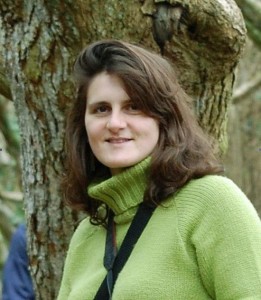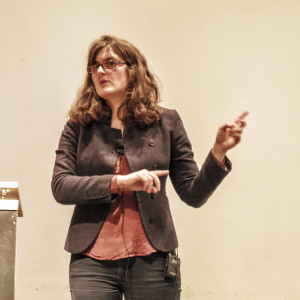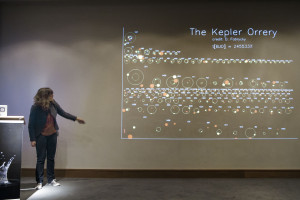February 11, 2013
Exploring the Diversity of Exoplanets
Dr Suzanne Aigrain
Report by: Chris Sutcliffe
The Flamsteed were delighted to welcome Dr Suzanne Aigrain, who is a lecturer in Astrophysics at the University of Oxford, and a fellow of All Souls College, specialising in the detection and characterisation of exoplanets.
Suzanne first drew our attention to the famous picture of Earth rising over the Moon, taken by astronaut William Anders of the Apollo 8 crew in December 1968, giving us our first insight into the Earth’s context within the Universe. Suzanne explained that this was what her research was all about… placing the Earth in its context. How do planets form and how common or unique are planets like the Earth? Ultimately, this has implications as to whether life will be found on other planets.
Suzanne asked us to think about the properties of the objects in the solar system. The Sun has 98.5% of the mass of the solar system, but more than 99% of the angular momentum (or spin) of the system is in the planets. This tells us something about how the planets are formed. All the planets are strikingly different; we have the terrestrial planets, the asteroids, the gas and ice giants and dwarf planets such as Pluto in the Kuiper Belt.
These ingredients allow us to form a theory of how the solar system formed:-
- Stars are formed from clouds of gas and dust which collapse under the force of gravity;
- Any turbulence or spin in the original cloud means that a disc is formed;
- In the disc there may be areas of increased density, so material accretes in these areas and forms planets.
- Once stars get hot enough, it will start to fuse hydrogen atoms into helium, getting brighter and emitting higher energy radiation and so evaporating the remnant gas and dust in the disc, leaving behind a star and planets revolving around the star.
There are 100 billion stars in the Milky Way, and 100 billion galaxies in the Universe. If each of these stars has planets in orbit around them, the number of possible planets outside the solar system (exoplanets) is huge. We would expect to find evidence of planetary formation along the same lines as our theory of solar system formation and, indeed, in the Orion nebula, we see evidence of protoplanetary discs (or “proplyds”) forming around new stars.
Following this introduction, Suzanne gave an outline of the techniques used to find exoplanets.
DIRECT IMAGING: Planets, typically, do not emit any light of their own. They can only be seen in reflective light from the star or in the light absorbed from the star re-emitted thermally in the infrared. However, this light is much fainter than the light from the star, so any exoplanet would be therefore very difficult to observe using this technique. We have, in the last few years, managed to detect a few exoplanets with this method, using large telescopes such as the VLT in Chile, or using space-based telescopes like the Hubble. The technique is becoming more feasible due to advances in adaptive optics, but it is still a very difficult technique and not widely used.
RADIAL VELOCITY TECHNIQUE (most widely used): This technique uses the consequences of the Doppler effect to measure light coming from stars. The spectrum of light from a star will produce defined absorption lines, depending on the elements with the star. The absorption lines will be shifted towards the blue or red depending on whether the star (or a planet in orbit around the star) is moving toward us or away from us. These absorption lines can be measured to an accuracy of one part in a billion. This is the type of accuracy needed to detect planets orbiting a star.
The first exoplanets to be discovered were of a type known as ‘Hot Jupiters’, as they have characteristics very similar to Jupiter, but orbit their star at a very close distance. This was a surprising finding, as theory predicts that there should not be enough material close in to the star to form a planet of this size and type. This most likely explanation is that the Hot Jupiters are formed far away from the star (beyond the ‘ice-line’) before migrating inwards. As these planets are so large and relatively common, they are the best studied of all exoplanets.
TRANSITS: A transit occurs when an exoplanet moves in front of its star and is the method that Suzanne works on to detect exoplanets. The method only works if the alignment of the orbit allows a transit to be viewable from Earth.
The amount of light detected from the star will dip slightly as the planet transits across the face of the star. The depth of this dip allows us to determine the ratio of the size of the planet in comparison to the star. The radial velocity method can give us the relative mass of the planet. With these figures, we can work out the density and therefore work out what the planet is made of. To date, we know of around 900 exoplanets, of which 150 have been discovered by the transit method.
Suzanne showed a graph showing the mass of exoplanets (in Jupiter masses) against orbital distance. It was clear that planetary systems with multiple planets are common, particularly with low-mass planets, but not in systems with ‘Hot Jupiters’. This provides us with clues as to how planets form. Planetary systems with ‘Hot Jupiters’ seem unlikely to have any smaller planets.
To find smaller planets, we have to observe from space, as instruments on the ground do not have sufficient sensitivity to measure the tiny dips in the light curve that a transiting small planet would cause.
The first space mission designed to search for exoplanets was CoRoT, a French Space Agency mission, which was active from 2006 to 2012 and monitored around 12,000 stars for a series of 6-month periods, searching for transit events (dips in the light curve). Part of the problem with analysing the data is the impact of star-spots on the surface of the stars, which can often look like transit events and also make measuring the radial velocity difficult.
The NASA Kepler mission is essentially a bigger version of CoRoT, with a 1-metre telescope and an enormous detector array. Kepler can monitor 100,000 stars at once and has been monitoring the same stars for around 5 years and will keep going until at least 2014. Kepler has found around 3,000 candidate planetary transit events to date.
Scientists need help and it is possible for amateur astronomers to get involved with the discovery of exoplanets via the website http://www.planethunters.org. Here, one looks at changes in star brightness, using data collected by NASA’s Kepler spacecraft.
Suzanne showed a wonderful diagram of some of the multiple planetary systems that have been discovered by Kepler so far (the ‘Kepler Orrery’).
Suzanne went on to say that the greatest challenge for the next five years will be the search for planets which may have life. If stars are close by and bright, it may be possible to look at the atmosphere of a planet and detect for signs of life. In 1761, the transit of Venus was observed by Mikhail Lomonosov, who detected, for the first time, an atmosphere on a planet other than Earth, by looking at the refraction of light from the Sun coming through Venus’s atmosphere.
We have used the same method for analysing the atmospheres of Hot Jupiters. This is the most likely way of detecting life on other planets, by looking for specific molecules in the atmosphere. However, there are many technical challenges to be overcome before we are able to make these observations for smaller ‘Earth-like’ planets.
Going forward, the next generation of space missions has to be selected, but there is always competition for limited resources. Thought provokingly, there will inevitably be the search for the signs of life, and maybe exoplanets will be discovered closer to home. The nearest confirmed exoplanet is about 18 light years away (unconfirmed exoplanets are only 4 light years away).
Our thanks to Suzanne for coming to the Flamsteed and giving such an interesting and absorbing lecture.
Pictures from the Evening (by Mike Meynell):
Posted under: Flamsteed, Flamsteed Lecture, Meeting Report









You must be logged in to post a comment.